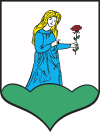Susz
Susz [suʂ] (German: Rosenberg in Westpreußen) is a town in Iława County, Warmian-Masurian Voivodeship, Poland, with 5,600 inhabitants (2004).
Susz | |
|---|---|
 Centre of the town | |
 Coat of arms | |
 Susz | |
| Coordinates: 53°43′12″N 19°20′14″E | |
| Country | |
| Voivodeship | Warmian-Masurian |
| County | Iława |
| Gmina | Susz |
| Area | |
| • Total | 6.67 km2 (2.58 sq mi) |
| Population (2006) | |
| • Total | 5,610 |
| • Density | 840/km2 (2,200/sq mi) |
| Postal code | 14-240 |
| Website | http://www.susz.pl |
Geographical location
Susz is located about 26 kilometres (16 miles) east of Kwidzyn, 48 kilometres (30 miles) south of Elbląg and 130 kilometres (81 miles) south-west of Kaliningrad at an altitude of 114 metres (374 feet) above sea level.
History
.jpg)
Throughout its history the town carried a rose in its coat of arms (in German Rosenberg means "rose hill"). Between 1871 and 1945 it was part of Germany, having been part of Prussia before. Finckenstein Palace was built in Susz. Around 1900 the town had a Protestant church, a Catholic church and a synagogue.
After World War I and the re-establishment of independent Poland, during the ongoing Polish-Bolshevik War, a plebiscite was held to determine whether the town was to be part of Germany or the Second Polish Republic on July 11, 1920. 33,498 voted to remain in Germany, 1,073 voted for Poland. Based on that result the town was included in the Regierungsbezirk Marienwerder within East Prussia. From October 26, 1939, until 1945 Rosenberg was part of Regierungsbezirk Marienwerder in the province of Reichsgau Danzig-West Prussia. During World War II Rosenberg was captured by the Red Army. After the end of war, the town became part of Poland under its Polish name Susz.
After the town had been put under Polish administration almost all German inhabitants who had remained in the town or had returned were expelled.
Ethnic structure in the 19th century
According to German data in 1846 the county of Rosenberg had 42480 inhabitants, by mother tongue 34380 (~81%) Germans and 8100 (~19%) Poles.[1]
Notable residents
- Artur Fürst (1880–1926), German-Jewish author
- Beata Żbikowska (born 1934), Polish Olympic middle-distance runner
- Krzysztof Trybusiewicz (born 1949), Polish Olympic modern pentathlete
References
- Belzyt, Leszek (1996). "Zur Frage des nationalen Bewußtseins der Masuren im 19. und 20. Jahrhundert (auf der Basis statistischer Angaben)". Zeitschrift für Ostmitteleuropa-Forschung (in German). Bd. 45, Nr. 1: 35–71 – via zfo-online.
- Johann Friedrich Goldbeck: Vollständige Topographie des Königreichs Preußen. Teil II, Marienwerder 1789, p. 10, no. 7.
- Der Große Brockhaus, 15th edition, Vol. 16, Leipzig 1933, pp. 101–102.
- Michael Rademacher: Deutsche Verwaltungsgeschichte Provinz Westpreußen, Kreis Rosenberg (2006).
- August Eduard Preuß: Preußische Landes- und Volkskunde. Königsberg 1835, p. 440, no. 56.